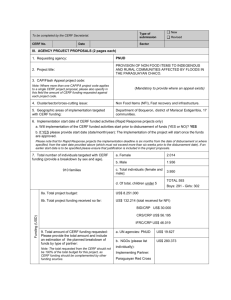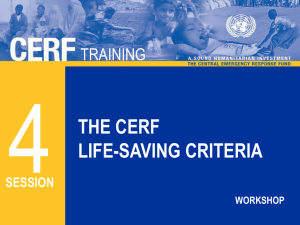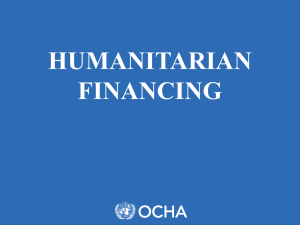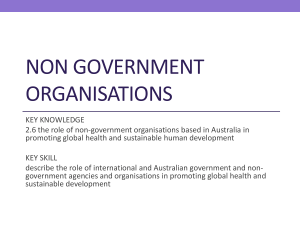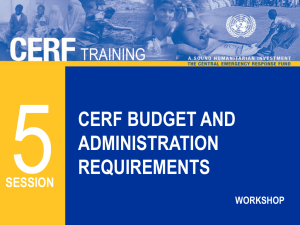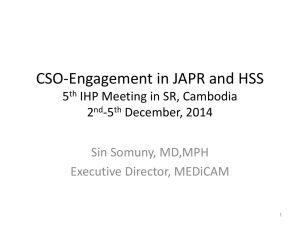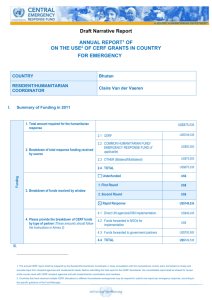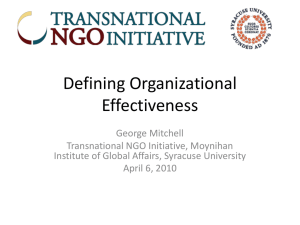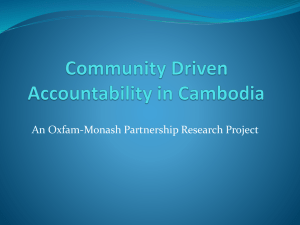CERF 6 - Working with Partners E Jul2012
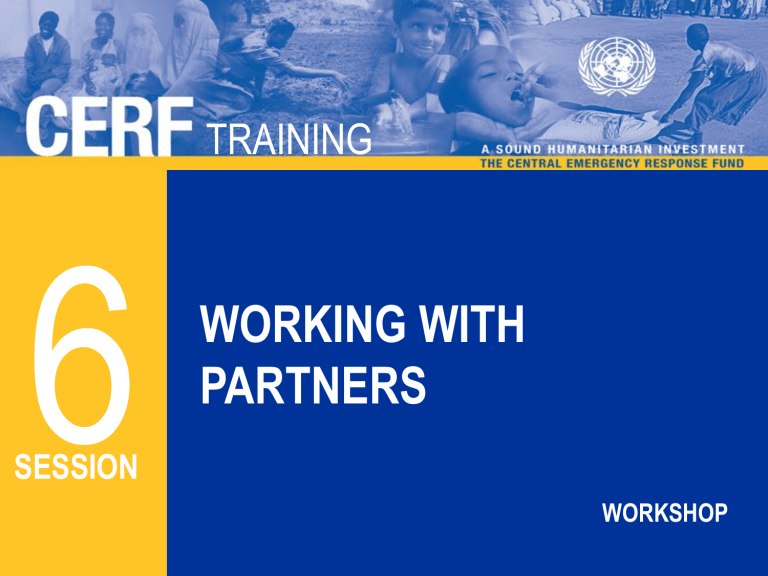
TRAINING
SESSION
WORKING WITH
PARTNERS
WORKSHOP
6
WORKING WITH PARTNERS
Objectives of this session
Understand how NGOs can benefit from the CERF Fund
• How NGOs benefit from CERF
•
• Alternatives for accessing CERF
Field-based prioritization and NGOs
• Recommendations
The role of the government in the CERF process
6
WORKING WITH PARTNERS
How do NGOs benefit from CERF
• NGOs receive funding indirectly as implementing partners of UN agencies and IOM
• NGOs, along with other humanitarian partners, also benefit from common services
Sudanese refugees from Darfur. UNHCR trucks deliver WFP food to a center in
Djabal camp, which hosts 14,000 refugees from Darfur [Photo: UNHCR/Caux]
6
Alternatives for accessing CERF
• Cluster leads proposing stand alone NGO projects for funding and assisting with the channeling of funding to NGOs
• Finding an “administrative agent”; for instance,
UNDP proposed NGO projects for funding and then passed the money to the NGOs for implementation
• Accessing other pooled funds (ERFs and CHFs)
WORKING WITH PARTNERS
6
WORKING WITH PARTNERS
Field-based prioritization and NGOs
• CERF guidance encourages RC/HCs to engage broader humanitarian actors in the prioritization of needs and the grant request
• NGOs can be more flexible in some cases to access hard to reach areas to assist people in need
• CERF is not about dividing the cake but improving response
•
•
•
•
Action Points
Strengthen the Humanitarian Country Teams and ensure broader NGO participation
Be proactive at sharing /obtaining information
Joint needs assessments
Use the Financial Tracking System
6
WORKING WITH PARTNERS
Principles of Partnership (2007)
Global Humanitarian Platform
•
•
•
•
•
Equality : respect between members (mandates, obligations and independence) and recognize each other's constraints and commitments.
Transparency : increase the level of trust by dialogue and sharing information
Result-oriented approach : based on effective capabilities and concrete operational capacities.
Responsibility : ethical obligation to each other to accomplish tasks responsibly, with integrity and in a relevant and appropriate way
Complementarity : build on comparative advantages of partners and complement each other’s contributions, taking into consideration local organizations
6
WORKING WITH PARTNERS
The role of the Government in the CERF process
• CERF prioritization and projects should be done in consultation with relevant government actors and country response plans, under RC/HC leadership.
However, no official proof of endorsement of a CERF project is required when submitting the application package.
• Government agencies are common implementation partners in CERF projects CERF can cover government
DSA, travel and operation costs , but cannot fund regular government salaries.
• Please read also the IASC Operational Guidance for cluster lead agencies on working with national authorities , July 2011
6
WORKING WITH PARTNERS
Awareness and information
•
•
•
•
•
•
CERF guidance material
3 NGO consortia participate in the IASC Humanitarian Financing Group
NGOs have been included in field based CERF training sessions
Studies by Oxfam and Save The Children on CERF website
Role of NGOs discussed with the Advisory Group
NGOs were invited to comment on life-saving criteria
6
Recommended next steps
• Establish clearer instructions from the CERF
Secretariat to UN agencies and IOM on increased involvement and participation of
NGOs in planning, implementation and joint evaluation of CERF-funded projects
• Encourage discussion at IASC Humanitarian
Financing Group regarding timeliness of pass-through funding to NGOs
WORKING WITH PARTNERS
6
RESOURCE
MATERIALS
WORKING WITH PARTNERS
Save the Children's experience with CERF in 2007
Save the Children, June 2007
The UN Central Emergency Response Fund One Year On
Oxfam Briefing Paper, 9 th March 2007
The NGOs and Humanitarian Reform Project,
Basic Information Leaflet on Financing
The Humanitarian Reform Project, June 2010
IASC Operational Guidance for cluster lead agencies on working with national authorities
IASC, 1 st July 2011
Available on the CERF website: http://cerf.un.org

